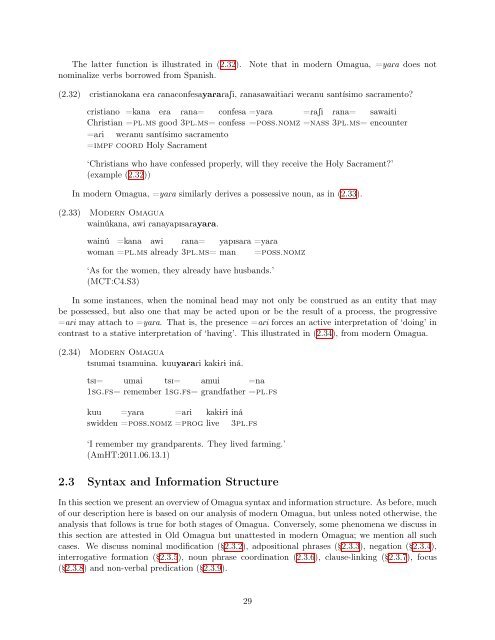draft manuscript - Linguistics - University of California, Berkeley
draft manuscript - Linguistics - University of California, Berkeley
draft manuscript - Linguistics - University of California, Berkeley
Create successful ePaper yourself
Turn your PDF publications into a flip-book with our unique Google optimized e-Paper software.
The latter function is illustrated in (2.32).<br />
nominalize verbs borrowed from Spanish.<br />
Note that in modern Omagua, =yaRa does not<br />
(2.32) cristianokana eRa RanaconfesayaRaRaSi, RanasawaitiaRi weRanu santísimo sacramento?<br />
cristiano =kana eRa Rana= confesa =yaRa =RaSi Rana= sawaiti<br />
Christian =pl.ms good 3pl.ms= confess =poss.nomz =nass 3pl.ms= encounter<br />
=aRi<br />
=impf<br />
weRanu<br />
coord<br />
santísimo sacramento<br />
Holy Sacrament<br />
‘Christians who have confessed properly, will they receive the Holy Sacrament?’<br />
(example (2.32))<br />
In modern Omagua, =yaRa similarly derives a possessive noun, as in (2.33).<br />
(2.33) Modern Omagua<br />
wainúkana, awi RanayapIsaRayaRa.<br />
wainú =kana awi Rana= yapIsaRa =yaRa<br />
woman =pl.ms already 3pl.ms= man =poss.nomz<br />
‘As for the women, they already have husbands.’<br />
(MCT:C4.S3)<br />
In some instances, when the nominal head may not only be construed as an entity that may<br />
be possessed, but also one that may be acted upon or be the result <strong>of</strong> a process, the progressive<br />
=aRi may attach to =yaRa. That is, the presence =aRi forces an active interpretation <strong>of</strong> ‘doing’ in<br />
contrast to a stative interpretation <strong>of</strong> ‘having’. This illustrated in (2.34), from modern Omagua.<br />
(2.34) Modern Omagua<br />
tsIumai tsIamuina. kuuyaRaRi kak1R1 iná.<br />
tsI= umai tsI= amui =na<br />
1sg.fs= remember 1sg.fs= grandfather =pl.fs<br />
kuu =yaRa =aRi kak1R1 iná<br />
swidden =poss.nomz =prog live 3pl.fs<br />
‘I remember my grandparents. They lived farming.’<br />
(AmHT:2011.06.13.1)<br />
2.3 Syntax and Information Structure<br />
In this section we present an overview <strong>of</strong> Omagua syntax and information structure. As before, much<br />
<strong>of</strong> our description here is based on our analysis <strong>of</strong> modern Omagua, but unless noted otherwise, the<br />
analysis that follows is true for both stages <strong>of</strong> Omagua. Conversely, some phenomena we discuss in<br />
this section are attested in Old Omagua but unattested in modern Omagua; we mention all such<br />
cases. We discuss nominal modification (§2.3.2), adpositional phrases (§2.3.3), negation (§2.3.4),<br />
interrogative formation (§2.3.5), noun phrase coordination (2.3.6), clause-linking (§2.3.7), focus<br />
(§2.3.8) and non-verbal predication (§2.3.9).<br />
29
















